英语人教版七年级上册说课稿
- 格式:docx
- 大小:14.93 KB
- 文档页数:7
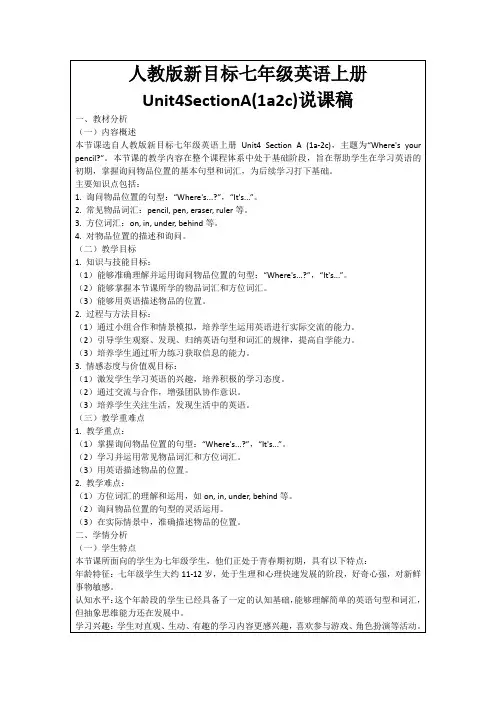
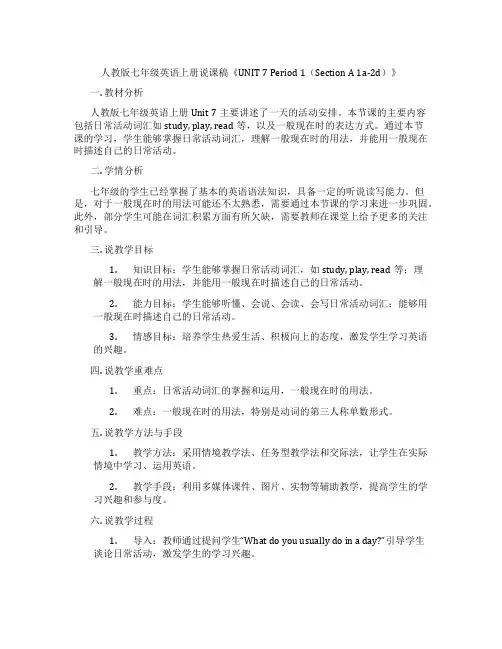
人教版七年级英语上册说课稿《UNIT 7 Period 1(Section A 1a-2d)》一. 教材分析人教版七年级英语上册Unit 7主要讲述了一天的活动安排。
本节课的主要内容包括日常活动词汇如study, play, read等,以及一般现在时的表达方式。
通过本节课的学习,学生能够掌握日常活动词汇,理解一般现在时的用法,并能用一般现在时描述自己的日常活动。
二. 学情分析七年级的学生已经掌握了基本的英语语法知识,具备一定的听说读写能力。
但是,对于一般现在时的用法可能还不太熟悉,需要通过本节课的学习来进一步巩固。
此外,部分学生可能在词汇积累方面有所欠缺,需要教师在课堂上给予更多的关注和引导。
三. 说教学目标1.知识目标:学生能够掌握日常活动词汇,如study, play, read等;理解一般现在时的用法,并能用一般现在时描述自己的日常活动。
2.能力目标:学生能够听懂、会说、会读、会写日常活动词汇;能够用一般现在时描述自己的日常活动。
3.情感目标:培养学生热爱生活、积极向上的态度,激发学生学习英语的兴趣。
四. 说教学重难点1.重点:日常活动词汇的掌握和运用,一般现在时的用法。
2.难点:一般现在时的用法,特别是动词的第三人称单数形式。
五. 说教学方法与手段1.教学方法:采用情境教学法、任务型教学法和交际法,让学生在实际情境中学习、运用英语。
2.教学手段:利用多媒体课件、图片、实物等辅助教学,提高学生的学习兴趣和参与度。
六. 说教学过程1.导入:教师通过提问学生“What do you usually do in a day?”引导学生谈论日常活动,激发学生的学习兴趣。
2.新课呈现:教师展示图片,引导学生说出图片中的日常活动,同时教授新词汇。
3.语法讲解:教师通过例句讲解一般现在时的用法,特别是动词的第三人称单数形式。
4.实践环节:学生分组进行角色扮演,用一般现在时描述自己的日常活动。
5.巩固环节:教师设计听力练习,让学生听懂、会用一般现在时描述日常活动。
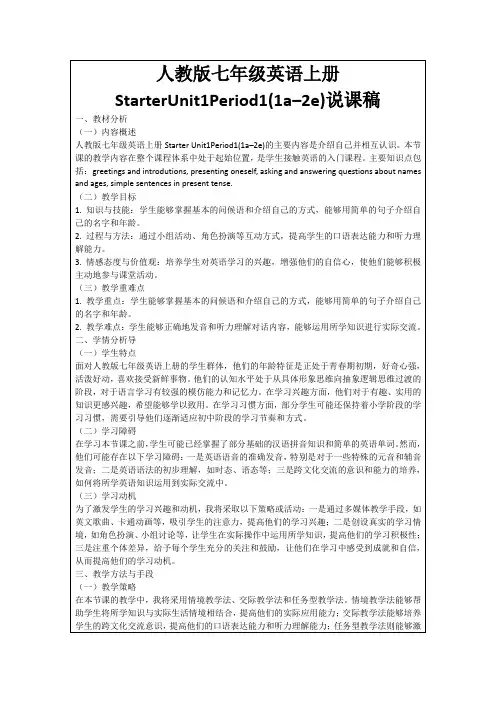
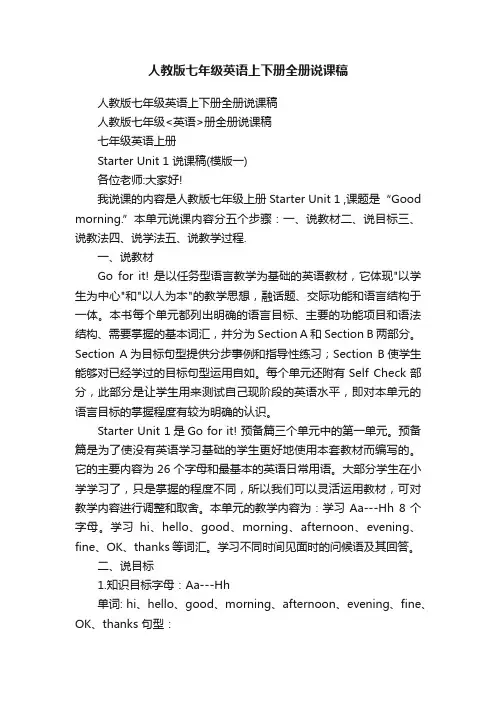
人教版七年级英语上下册全册说课稿人教版七年级英语上下册全册说课稿人教版七年级<英语>册全册说课稿七年级英语上册Starter Unit 1 说课稿(模版一)各位老师:大家好!我说课的内容是人教版七年级上册Starter Unit 1 ,课题是“Good morning.”本单元说课内容分五个步骤:一、说教材二、说目标三、说教法四、说学法五、说教学过程.一、说教材Go for it! 是以任务型语言教学为基础的英语教材,它体现"以学生为中心"和"以人为本"的教学思想,融话题、交际功能和语言结构于一体。
本书每个单元都列出明确的语言目标、主要的功能项目和语法结构、需要掌握的基本词汇,并分为Section A和Section B两部分。
Section A为目标句型提供分步事例和指导性练习;Section B使学生能够对已经学过的目标句型运用自如。
每个单元还附有Self Check部分,此部分是让学生用来测试自己现阶段的英语水平,即对本单元的语言目标的掌握程度有较为明确的认识。
Starter Unit 1是Go for it! 预备篇三个单元中的第一单元。
预备篇是为了使没有英语学习基础的学生更好地使用本套教材而编写的。
它的主要内容为26个字母和最基本的英语日常用语。
大部分学生在小学学习了,只是掌握的程度不同,所以我们可以灵活运用教材,可对教学内容进行调整和取舍。
本单元的教学内容为:学习Aa---Hh 8个字母。
学习hi、hello、good、morning、afternoon、evening、fine、OK、thanks等词汇。
学习不同时间见面时的问候语及其回答。
二、说目标1.知识目标字母:Aa---Hh单词: hi、hello、good、morning、afternoon、evening、fine、OK、thanks 句型:1).--Good morning, Alice! ---Good morning !2).--Hello, Frank!--Hi, Cindy! How are you? --I'm fine/OK, thanks.2. 能力目标训练学生听、说、读、写的能力。
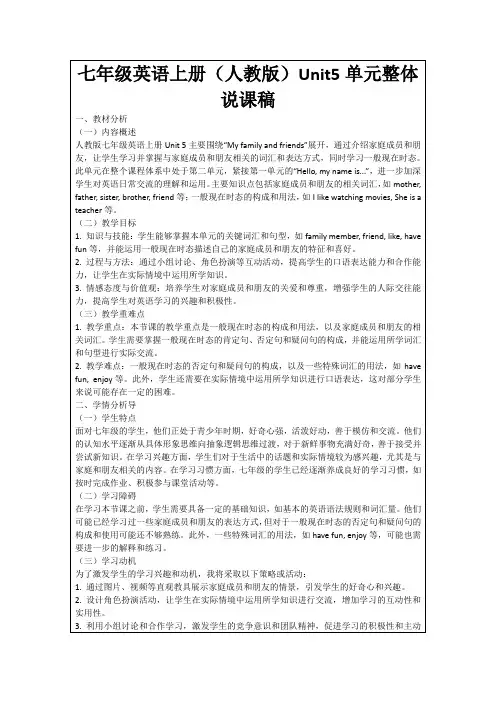

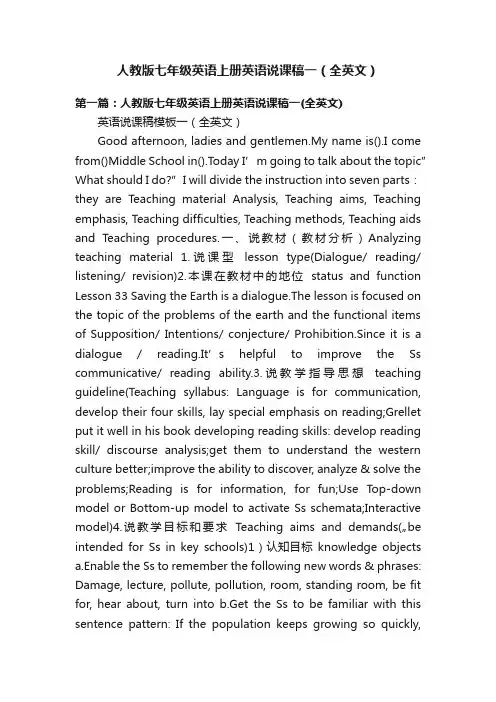
人教版七年级英语上册英语说课稿一(全英文)第一篇:人教版七年级英语上册英语说课稿一(全英文)英语说课稿模板一(全英文)Good afternoon, ladies and gentlemen.My name is().I come from()Middle School in().T oday I’m going to talk about the topic” What should I do?”I will divide the instruction into seven parts:they are Teaching material Analysis, Teaching aims, Teaching emphasis, Teaching difficulties, Teaching methods, Teaching aids and Teaching procedures.一、说教材(教材分析)Analyzing teaching material 1.说课型lesson type(Dialogue/ reading/ listening/ revision)2.本课在教材中的地位status and function Lesson 33 Saving the Earth is a dialogue.The lesson is focused on the topic of the problems of the earth and the functional items of Supposition/ Intentions/ conjecture/ Prohibition.Since it is a dialogue / reading.It’s helpful to improve the Ss communicative/ reading ability.3.说教学指导思想teaching guideline(Teaching syllabus: Language is for communication, develop their four skills, lay special emphasis on reading;Grellet put it well in his book developing reading skills: develop reading skill/ discourse analysis;get them to understand the western culture better;improve the ability to discover, analyze & solve the problems;Reading is for information, for fun;Use T op-down model or Bottom-up model to activate Ss schemata;Interactive model)4.说教学目标和要求Teaching aims and demands(…be intended for Ss in key schools)1)认知目标knowledge objects a.Enable the Ss to remember the following new words & phrases: Damage, lecture, pollute, pollution, room, standing room, be fit for, hear about, turn into b.Get the Ss to be familiar with this sentence pattern: If the population keeps growing so quickly,there will only be standing room left… Give the Ss a reinforced practice on the functional item Supposition.c.Activate Ss schemata regarding the topic of pollution and help Ss to know more about the problem of pollution.2)智能目标 ability objects a.Ask the Ss to make up a similar dialogue.b.Help them to understand the dialogue better and improve the four skills.c.Develop their ability of thinking independently.d.Cultivate their ability to discover, analyze and solve problems.e.Train them to collect information from the Internet.f.Train them with some effective learning methods to optimize Ss’ learning res ults.3)德育目标moral objects a.Arouse their interest in learning English;b.Help them to understand the background of pollution.c.Enable the students to love our earth and the nature.d.Be aware of the importance of stopping pollution & protecting out environment.e.Encourage the Ss to do something to save the earth.5.说教学重点 teaching important points(生词、句型;培养阅读技能)a.New words and phrases b.Sentence pattern: If-clause c.improve their reading skills.d.Talking about problems of the Earth.6.说教学难点 teaching difficult points(语法;发展交际能力)a.functional item: Supposition.b.Develop their communicative ability.Act out their own dialogue.7.说教具teaching aids(multi-media computer, software, OHP)The teaching syllabus says that it’s necessary for teachers to use modern teaching facilit ies.It’s of great help to increase the class density and improve our teaching result.It can also make the Ss reach a better understanding of the text by making the classes lively and interesting.At the same time, it arouses the Ss’ interest in learning English.二、说教法T eaching methods Five step method;audio-video;communicative approach;Task-based learning: New Syllabus Design encourages teachers to use thisteaching method.TBLT can stimulate Ss’ initiative in learning and develop their ability in language application.Make the Ss the real masters in class while the teacher himself acts as the director and bring their ability into full play.三、说学法Study methods 1.Teach Ss how to be successful language learners.2.Teach Ss how to develop the reading skill — skim & scan;how to communicate with others;how to learn new words;how to learn independently;3.Get the Ss to form good learning habits.四、说教学过程Teaching procedures I.复习(Revision)5min(Daily report;词汇diagram;brainstorming;activate schemata)Activity 1: Imagination 1).Suppose a bottle of ink is turned over and dirties your white shirt, what is to be done?(Wash it? Or throw it away?)2).Suppose you catch a bad cold, what’s to be done?3).Suppose your bike is broken, what’s to be done?4).And suppose the earth, on which we all live, is damaged, what’s to be done? * What can you think of when you see “pollution” this word?(waste, environment, air, water, factory, desert, climate...Try to activate the Ss schemata regarding the topic of pollution.)II.呈现(Presentation)5min Activity 2: Presentation Play the song “Earth Song” sung by Michael Jackson.(Create an atmosphere)A lot of pictures and video clips about the causes and results of the three problems mentioned in this lesson will be shown on the screen with the help of the comp uter.Ss’ presentation on pollution.Attract their attention, arouse their interest, and create a good atmosphere for communication.* Activate their schemata and cultivate their ability in collecting information from the Internet and develop their ability in thinking independently.III.对话/ 阅读(Dialogue)18m 1.Pre-reading Activity 3: Prediction 1st listening/ fast reading, one guided Q to help Ss to get the main idea: Whatdo you think is discussed at the conference? 2.While-reading Activity 4: Read and answer 2nd listening/ careful reading, more Qs to get the detailed information.Develop their reading skills: skim & scan.Pay attention to the pronunciation, stress & intonation.* 阅读: Pre-reading;while-reading;post-reading(fast reading/ careful reading;skim/ scan;识别关键词key words;确定主题句;创设信息差information gap;T or F;填表格chart/diagram;Predicting;Make a timeline;Make a story map。
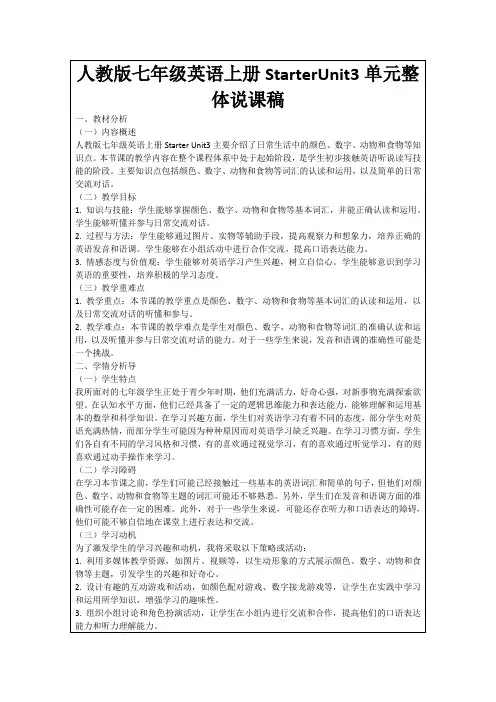
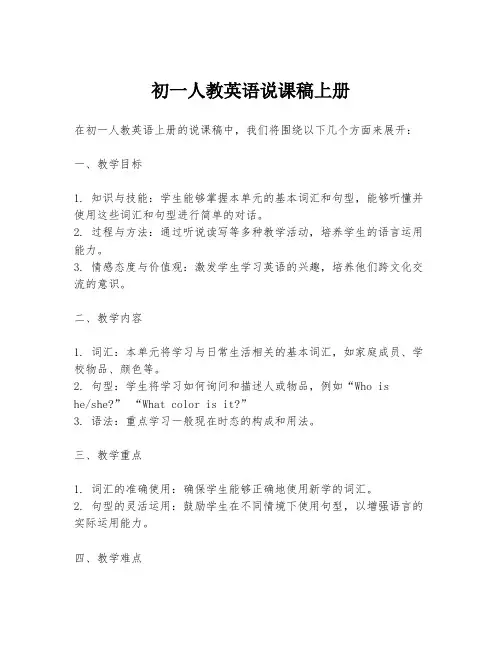
初一人教英语说课稿上册在初一人教英语上册的说课稿中,我们将围绕以下几个方面来展开:一、教学目标1. 知识与技能:学生能够掌握本单元的基本词汇和句型,能够听懂并使用这些词汇和句型进行简单的对话。
2. 过程与方法:通过听说读写等多种教学活动,培养学生的语言运用能力。
3. 情感态度与价值观:激发学生学习英语的兴趣,培养他们跨文化交流的意识。
二、教学内容1. 词汇:本单元将学习与日常生活相关的基本词汇,如家庭成员、学校物品、颜色等。
2. 句型:学生将学习如何询问和描述人或物品,例如“Who ishe/she?” “What color is it?”3. 语法:重点学习一般现在时态的构成和用法。
三、教学重点1. 词汇的准确使用:确保学生能够正确地使用新学的词汇。
2. 句型的灵活运用:鼓励学生在不同情境下使用句型,以增强语言的实际运用能力。
四、教学难点1. 词汇记忆:由于学生刚开始接触英语,记忆词汇可能会有难度。
2. 语法理解:一般现在时态的构成和使用可能会对学生来说是一个挑战。
五、教学方法1. 情景教学:通过设置具体的情景,让学生在实际语境中学习和使用语言。
2. 合作学习:鼓励学生进行小组合作,通过角色扮演等活动加深对语言的理解和记忆。
3. 多媒体教学:利用图片、音频、视频等多媒体资源,增强教学的趣味性和实效性。
六、教学过程1. 导入:通过展示图片或视频,激发学生对本单元主题的兴趣。
2. 呈现:教师展示新词汇和句型,并通过重复和举例帮助学生理解。
3. 练习:学生通过填空、对话练习等形式巩固所学知识。
4. 应用:设置情景,让学生运用所学知识进行实际对话。
5. 总结:回顾本节课的重点内容,确保学生能够掌握。
七、作业布置1. 词汇练习:要求学生记忆并正确拼写本单元的词汇。
2. 句型运用:设计一些简单的对话练习,让学生在家庭作业中使用新学的句型。
3. 听力练习:提供相关的听力材料,让学生练习听力理解能力。
八、板书设计- 单元主题- 新词汇列表- 重点句型- 语法点通过这样的说课稿,我们希望能够为学生提供一个全面、系统的英语学习体验,帮助他们在轻松愉快的氛围中提高英语能力。
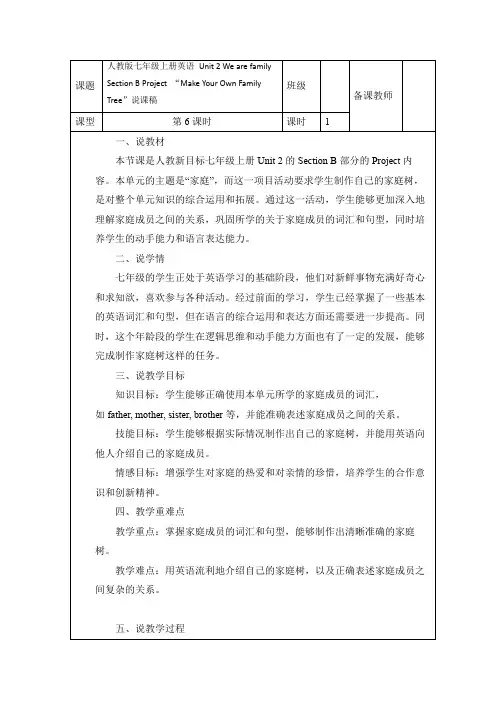
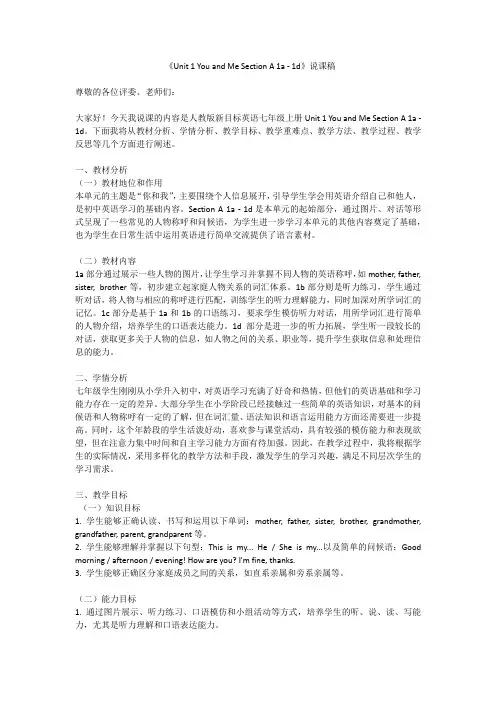
《Unit 1 You and Me Section A 1a - 1d》说课稿尊敬的各位评委、老师们:大家好!今天我说课的内容是人教版新目标英语七年级上册Unit 1 You and Me Section A 1a -1d。
下面我将从教材分析、学情分析、教学目标、教学重难点、教学方法、教学过程、教学反思等几个方面进行阐述。
一、教材分析(一)教材地位和作用本单元的主题是“你和我”,主要围绕个人信息展开,引导学生学会用英语介绍自己和他人,是初中英语学习的基础内容。
Section A 1a - 1d是本单元的起始部分,通过图片、对话等形式呈现了一些常见的人物称呼和问候语,为学生进一步学习本单元的其他内容奠定了基础,也为学生在日常生活中运用英语进行简单交流提供了语言素材。
(二)教材内容1a部分通过展示一些人物的图片,让学生学习并掌握不同人物的英语称呼,如mother, father, sister, brother等,初步建立起家庭人物关系的词汇体系。
1b部分则是听力练习,学生通过听对话,将人物与相应的称呼进行匹配,训练学生的听力理解能力,同时加深对所学词汇的记忆。
1c部分是基于1a和1b的口语练习,要求学生模仿听力对话,用所学词汇进行简单的人物介绍,培养学生的口语表达能力。
1d部分是进一步的听力拓展,学生听一段较长的对话,获取更多关于人物的信息,如人物之间的关系、职业等,提升学生获取信息和处理信息的能力。
二、学情分析七年级学生刚刚从小学升入初中,对英语学习充满了好奇和热情,但他们的英语基础和学习能力存在一定的差异。
大部分学生在小学阶段已经接触过一些简单的英语知识,对基本的问候语和人物称呼有一定的了解,但在词汇量、语法知识和语言运用能力方面还需要进一步提高。
同时,这个年龄段的学生活泼好动,喜欢参与课堂活动,具有较强的模仿能力和表现欲望,但在注意力集中时间和自主学习能力方面有待加强。
因此,在教学过程中,我将根据学生的实际情况,采用多样化的教学方法和手段,激发学生的学习兴趣,满足不同层次学生的学习需求。
人教版中学七年级英语上册全册说课稿一. 教材分析人教版中学七年级英语上册全册说课稿的教材分析主要从教材内容、教材结构、教材目标和教材特点四个方面进行。
1.教材内容:本册教材共分为12个单元,每个单元包括课文、词汇、语法、功能项目、听力、口语、写作和文化角等部分。
教材内容丰富,涵盖了日常生活中的各种场景,旨在培养学生的综合语言运用能力。
2.教材结构:本册教材的结构清晰,每个单元的主题明确,各部分内容相互关联,形成一个有机的整体。
课文部分以故事、对话等形式呈现,词汇和语法部分分别针对本单元的主题进行讲解和练习,功能项目部分则通过实际场景的模拟,培养学生的实际应用能力。
3.教材目标:本册教材的目标是使学生掌握基础英语知识,提高听、说、读、写四项基本技能,培养学生的语言运用能力和跨文化交际能力。
4.教材特点:本册教材具有以下特点:(1)实用性:教材内容紧密结合学生的生活实际,有利于学生将英语应用于实际生活中;(2)趣味性:教材以学生感兴趣的话题为主题,采用生动、有趣的形式呈现,激发学生的学习兴趣;(3)针对性:教材针对中国学生的学习特点,进行有针对性的教学设计,提高教学效果。
二. 学情分析学情分析主要从学生的年龄特点、知识基础、学习兴趣和特点以及学习需求等方面进行。
1.学生年龄特点:七年级的学生正处于青春发育期,对新鲜事物充满好奇,具有较强的学习能力和模仿能力。
2.知识基础:大部分学生已经掌握了26个字母,对简单的单词和句子有一定的了解,但英语听说能力较差,语法知识较弱。
3.学习兴趣和特点:学生对英语学习具有一定的兴趣,但容易受到母语的影响,学习过程中容易产生挫败感。
4.学习需求:学生需要通过系统的英语学习,提高听、说、读、写四项基本技能,为今后的学习和生活打下良好的基础。
三. 说教学目标1.知识目标:使学生掌握本单元的单词、短语、句型和语法知识。
2.能力目标:提高学生的听、说、读、写四项基本技能,培养学生的语言运用能力和跨文化交际能力。
人教版七年级上册英语说课稿第一篇:人教版七年级上册英语说课稿人教版七年级上册Unit6 Do you like bananas? 说课稿各位老师、同学大家好!今天我要谈的是人教版新目标英语七年级上册Unit 6 Do you like bananas? 第一课时的教学。
一、教材分析(一)教材的地位和作用本单元学习的是与学生生活密切相关的话题食物,由Section A , Section B 和Self check三个部分组成。
本节课是第六单元的第一课时,因此主要是Section A 部分的内容。
教材内容围绕着谈论喜欢与不喜欢的食物展开,易于激发学生的学习兴趣。
本课时以听说为主,要求学生在学习活动中运用所学单词和句型进行交际,有助于培养学生的口语表达能力和综合语言运用能力。
(二)教学目标《课程标准》中说:英语教学的目的是培养学生运用语言进行交际的能力,为用而学,在用中学,学了就用。
因此我把本课的教学目标定为以下几个方面:1.知识目标1)通过对本节课的学习,学生将能够认识并掌握一些有关食物方面的单词,如hamburger, French fries, salad, strawberry, broccoli.2)能理解并正确使用以下句型:Do you like…? Yes, I do./No,I don’t.2.能力目标1)能用本课所学句型自由的谈论喜欢喝不喜欢的食物。
2)能区分可数名词和不可数名词。
3.情感目标1)在小组合作中积极参与讨论,互相帮助,团队合作意识增强。
2)能够养成健康合理的饮食习惯,学会关心父母。
(三)教学重点及难点1.教学重点:掌握各种有关食物方面的名词;实义动词like一般现在时的疑问是及其答语。
2.教学难点:如何谈论自己的喜好和厌恶;区分可数名词和不可数名词。
二、学生分析初一学生性格特点是活泼好动,爱表现,参与活动的热情会很高。
面对可塑性很强的学生,作为英语教师,我们一定要保护他们对英语学习的热情。
Unit7 Will people have robots 2b说课稿Hello,everyone. Today I’m very pleased to have the opportunity to share my teaching ideas with all of you here. My topic today is taken from Section B 2b Unit 7Will people have robots ? I will divide my instructions into seven parts. They are1.Teaching Material Analysis;2.Teaching Aims;3.Teaching Emphasis;4.Teaching Difficulties;5.Teaching Methods;6.Teaching Aids ;7.Teaching Procedures.Part 1 Teaching Material AnalysisThis lesson is a reading material about robots. It is focused on the predictions of our future life. Such a topic is related to students’ daily life and all of the students have something to say. So the passage is a good example to show how life is like in the future. And it lays afoundation for the output in main task. Therefore, this lesson is in the important position of the teaching material.Part 2.Teaching Aims1. Knowledge Aims:After the lesson, students should be able to(1) Master the four-skilled words and phrases.(2) Learn to talk about the future and make predictions about what robots will look like and what robots can do in the future and so on..2. Ability Aims:(1) Improve students reading skills, such as skimming scanning, especially identifying the main idea for each paragraph and consider what questions are answered by each paragraph.(2) Learn to describe how future robots will help humans.3. Emotional Aims:(1) To develop students’ imagination , help them open up their minds and build their confidence by making predictions.(2) To make students realize if they want to make their predictions come true, they should first work hard in study.(3) To let students know every coin has two sides and learn about the advantages and disadvantages science has given us.Part3. Teaching Emphasis1. Infer the main idea of the passage according to the title.2. Learn about what robots can do now and what robots will be able to do in the future.Part4. Teaching Difficulties1. Understand some difficult words, phrases and sentences.2. Be able to make predictions about what robots will do in the future.3. Give opinions about whether it is good for humans to live with a lot of robots in the future.Part5. Teaching Methods1. The method of discussing (讨论法)Discuss what robots look like now and what robots will look like in the future .Discuss what robots can do now and what robots will do in the future.2. The intuitive method of teaching.(直观法)Lead in by a video to arouse students interest.3. The task-based teaching approach(任务型教学方法)The whole teaching process will be carried out by learning and reading tasks. During the process, the students will become the real masters of their learning and reading, while the teacher acts as a director. In this way the learners will experience the knowledge and eventually acquire it.Part 6. Teaching Aids.I will use multi-media(PPT,video), making the class more lively and interesting .I will also use some traditional teaching aids,such as blackboard, cards and chalks.Part7. Teaching ProceduresStep1. Lead- in by showing a video about robots .Lead students discuss what robots look like and what they can do in 2035 according to the video.(Purpose: To stimulate students’ interest and focus students’ attention to the class. At the same time lea d in today’s topic.)Step2. While-reading1. PredictingLook at the title of the passage and the picture on the book page 53. Predict what the passage is talking about.(Purpose: To develop the ability of predicting what the passage is talking about according to the title and the information appeared in the reading material including the pictures.)2. Fast ReadingSkimmingRead the passage quickly and finish 2b. Then get the main idea of each paragraph.Tips: Reading for meaning, not for details(Purpose: To develop the skills of skimming . And let students read with tasks to improve their reading ability.)3. Careful Reading(1) ScanningRead the passage paragraph by paragraph with different tasks. Read Para. 1, and answer :A. In what kind of movies ,we sometimes see robots?B. What are they like?Read Para. 2. complete the sentences.A. Robots can build_____________ in factories.B. They can do ______jobs many times and not get bored.Read Para. 3 decide True or False.( )1.Some robots in Japan are fun to watch, because they can dance and walk.( )2.scientists are trying to make robots look like animals.( )3.we can make robots move like people and think like a human . ( )4.Scientist James White believes that robots will never be able to do the samethings as we can.Read Para 4. complete the diagram.Robots in the futureAt last make a summary with a mind map.(2) Read with the tape and finish 2d(Purpose: To develop the skills gaining the details of the article. Reading aloud with the tape to correct some pronunciation of the new words and expressions . )Step3. After-reading1. Discussion and performingStudents work in groups to act as some scientists and discuss what will robots help do in the future and whether it is possible for humans to live with robots.Students show themselves by acting out their conversations. (Purpose: To arouse students’ creativity and imagination. Make them more confident to face the life now and the life in the future ) 2. DebatingDivide students into two groups to debate the advantages anddisadvantages to live with a lot of robots in the future. (Purpose: To make students realize every coin has two sides. Although robots make our life more comfortable and convenient, they do have some disadvantages living with them. )Step 4. Homework:Write a letter to a robot scientist . Students can have two choices:(1)Tell him what other things you think robots can do .(2) Or tell him whether it is possible for humans to live with robots and why you think so.(Pur pose: To turn reading into writing. Develop students’ creativity and love for future life. Assign different tasks for students with different levels. )Teaching Reflection:During my teaching, I’ll try my best to encourage every student to practice English. And I pay much attention to learner guidance. I design some tasks in order to help them develop the reading skills and acquire the language naturally.。